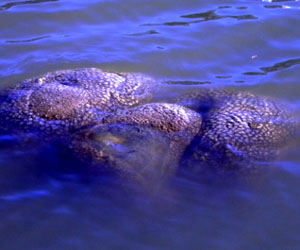 Photo credit Mr. Charles Schmuck. This freshwater bryozoa was found in the lake in City Center at Oyster Point. Bryozoans are filter feeders that live in encrusting and branching colonies, mostly in seawater. This particular colony, pictured is about 4 feet in diameter; most colonies of marine bryozoans occur as thin sheets. Marine bryozoans are common but inconspicuous filter feeders that grow in thin, encrusting colonies atop rocks, kelp blades, shellfish, and other hard objects. When the individual animals extend their tentatcles to feed, the colony takes on a fuzzy appearance, hence the bryozoans' common name of "moss animal." Although individual bryozoans are built on a simple plan - a U-shaped gut inside a bag-like body with no lungs or gills, and no circulatory or excretory system - they are true survivors, with a fossil record that dates back some 500 million years. Freshwater bryozoans are far less diverse than their marine cousins, with only about 50 species worldwide, but what they lack in numbers they make up for in size - like the 4-foot blob found above. The pictured blob is actually much larger than most reports for the species, which put a large colony at only 1-2 feet across. Colonies of Pectinatella magnifica feature a surface layer of adjoining "rosettes" - each with 12-18 animals or "zooids" - around a central jelly-like mass that is 99% water. The colonies can be free floating or attached to a piling or other submerged object. One study even showed that young colonies of P. magnifica can actually move on their own by coordinated pulsing of the individual animals. At Virginia Institute of Marine Science (VIMS) professor Carl Hershner notes that bryozoans consume algae, so the "alien pod" is "actually a good thing to have around, despite its looks." "It's not a sign of bad water quality," he adds, "and it doesn't hurt fish. It can clog pipes, though, and it will be smelly if it's removed from the water." |
Wednesday, November 10, 2010
Freshwater Bryozae are not aliens
Subscribe to:
Post Comments (Atom)






No comments:
Post a Comment